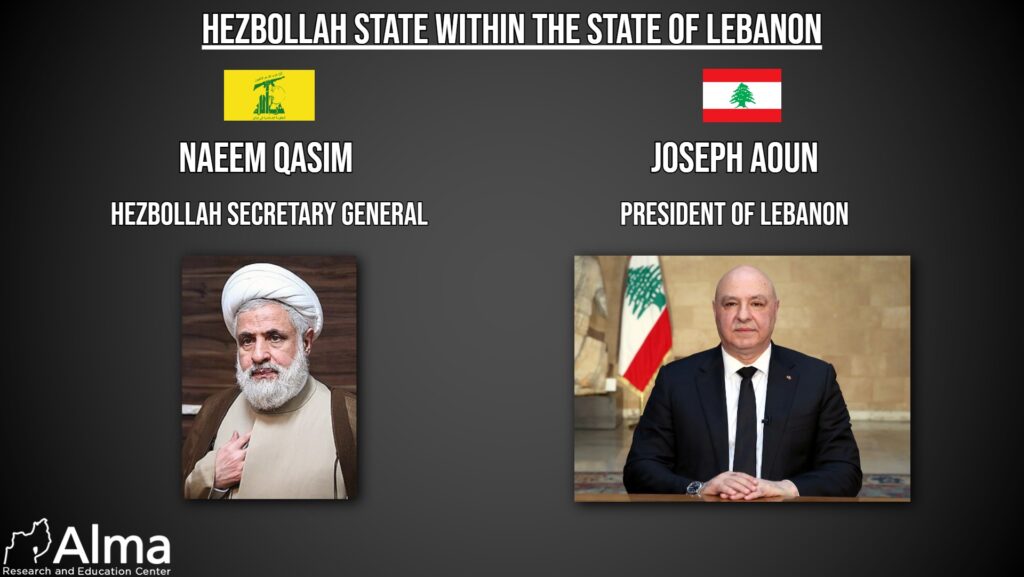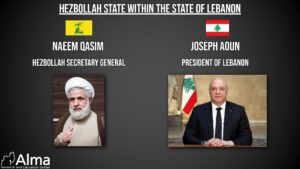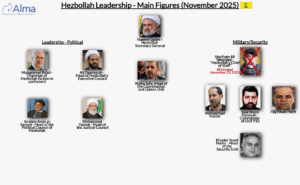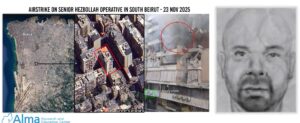One year into the ceasefire following Operation Northern Arrows, which severely degraded Hezbollah’s capabilities and command structure, Lebanon remains a failed entity lacking the sovereign capacity to exercise authority over its own territory.
In its place stands a hollow shell hosting the ‘State of Hezbollah’—a parasitic ‘state-within-a-state’ that retains military and economic superiority despite the severe damage it sustained during the war with Israel.
This assessment is being articulated with increasing clarity by U.S. representatives.
For example, U.S. Special Envoy to Syria and Ambassador to Turkey, Tom Barrack addressed this issue during the Manama Dialogue hosted by the International Institute for Strategic Studies (IISS) in Bahrain (held between October 31 and November 2).
During the conference, Barrack’s assessment—backed by specific data on the economic and military disparities between the Lebanese Armed Forces (LAF) and Hezbollah—led him to conclude that Lebanon is a “failed state” where the balance of power has tipped decisively in Hezbollah’s favor.
Lacking a functioning central bank, burdened by a shattered banking system with a multi-billion dollar deficit, and with a former central bank governor fleeing criminal charges across Europe, the Lebanese state has lost its economic engine, according to Barrack.
This sovereign vacuum was not left empty; it was quickly and efficiently filled by Hezbollah.
“The state is Hezbollah,” Barrack declared at the conference, noting that in southern Lebanon, the terror organization—not the government—provides water, education, health services, and subsistence allowances to the population (primarily Shiite) through its civilian infrastructure managed by its Executive Council.
Hezbollah’s displacement of the state is the fundamental obstacle to implementing UN Security Council Resolution 1701, which calls for the group’s disarmament in southern Lebanon.
Israel continues to strike targets in Lebanon not out of territorial ambition, but because—as Barrack noted—”thousands of rockets” remain embedded in southern Lebanon, posing an active and intolerable threat to the Israeli home front.
The assumption that a bankrupt government in Beirut can order the disarmament of a force that feeds its people and outguns its army is, in the current analysis, a dangerous diplomatic fiction.
This conclusion gains further traction considering the Alma Center’s assessment that at least half of the Lebanese Army consists of Shiite soldiers and commanders.
The Economic Asymmetry: An 8-to-1 Ratio in Buying Loyalty
According to data presented by the American envoy in Manama, a Hezbollah operative currently earns approximately $2,200 per month.
In contrast, a Lebanese Army soldier earns merely $275 per month.
This 8-to-1 ratio in favor of the Iranian proxy creates an insurmountable retention and morale crisis for the Lebanese National Army.
While LAF soldiers struggle to feed their families, Hezbollah operatives and their dependents enjoy a shadow economy subsidized by Iran, insulating them from the hyperinflation raging across the rest of the country.
This financial gap is structural and intentional. Despite U.S. sanctions, Iran’s Islamic Revolutionary Guard Corps (IRGC) transferred over $1 billion to Hezbollah in the first ten months of 2025 alone, utilizing a shadow banking network of money exchangers to bypass the formal financial system.
Concurrently, Hezbollah’s quasi-banking institution, Al-Qard Al-Hasan, has demonstrated extraordinary resilience.
Even after being directly targeted by the Israeli Air Force in October 2024 to cripple the organization’s economy, the institution rapidly rehabilitated its branches, reopening them by May 2025. This move was designed to project stability and economic security to the Shiite support base—security the Lebanese state cannot provide.
Attempts by the Lebanese state to directly or indirectly restrict Al-Qard Al-Hasan’s activities were met with clear declarations from Hezbollah leader Naim Qassem that such actions constitute a casus belli.
The strategic significance is clear: for a young Shiite man in southern Lebanon, joining Hezbollah is not merely an ideological choice but a rational economic survival strategy.
The Lebanese Army, reliant on sporadic international aid, cannot compete with a ‘state within a state’ that functions as a stable employer of last resort.
The Military Imbalance: Quantity vs. Quality
While the Lebanese Army nominally maintains a larger headcount—with approximately 60,000 troops in standing and regular service compared to Hezbollah’s estimated 40,000 military operatives (according to Barrack)—this numerical advantage is fundamentally misleading.
Modern warfare is defined by advanced weapon systems, precision missiles, and firepower, not merely by the number of boots on the ground.
Barrack noted that Hezbollah retains 15,000 to 20,000 missiles and rockets, a significant arsenal even after the dramatic attrition suffered during the “Swords of Iron” war.
Data from the Alma Center corroborates this, estimating that while Hezbollah’s pre-war stockpile of roughly 75,000 rockets and missiles was reduced, the remaining arsenal of 20,000 to 25,000 includes precision munitions.
Furthermore, Hezbollah has shifted its operational and logistical center of gravity north of the Litani River and into the Bekaa Valley. There, it utilizes deep strategic tunnels and indigenous production sites to manufacture weapons locally, thereby mitigating disruptions to land supply lines.
Conversely, the Lebanese Army lacks modern heavy armor and advanced UAV capabilities, placing it at a total technological disadvantage. As Barrack asked rhetorically, which army is which?—implying that in terms of capability, logistics, and power, the non-state actor has completely eclipsed the state.
The Sectarian Deadlock: Why the Lebanese Army Will Not Disarm Hezbollah
Beyond economic and military disparities lies a deeper, more entrenched obstacle to disarmament: the sectarian composition and internal loyalties of the Lebanese Army itself.
The Western expectation that the Lebanese Army will forcibly disarm Hezbollah ignores the demographic and social realities of the military and the fractured Lebanese state.
According to the Alma Center, the Lebanese Army has undergone a quiet but consistent process of “Shi’ization” over the last decade.
Estimates indicate that 45% to 60% of Lebanese Army soldiers are now Shiite Muslims.
This shift is driven by demographics—higher birth rates within the Shiite community—and economics, as the army remains one of the few stable employment options for working-class Shiite youth, while many Christians and Sunnis have turned to the private sector, or to emigration.
This composition creates a ‘Trojan Horse’ dynamic within the ranks. In any scenario where the LAF high command orders a direct confrontation or a forced attempt to disarm Hezbollah, the army would likely fracture along sectarian lines. This would almost certainly lead to civil war—a scenario that everyone in Lebanon, including Hezbollah’s staunchest opponents, is “scared to death of,” in Barrack’s words.
The loyalty of a Shiite soldier from southern Lebanon—whose family relies on Hezbollah for water, electricity, education, health, and home reconstruction grants—lies first and foremost with his community and its “protector,” not with a bankrupt government in Beirut incapable of meeting basic needs.
Worse yet, Hezbollah has penetrated deep into the LAF’s intelligence and command structures, effectively turning parts of the military into auxiliary assets.
Summary: The Permanence of Instability
The picture painted at the Manama Dialogue is grim but essential for a realistic assessment of the situation in Lebanon.
Lebanon is a failed state where the monopoly on firepower is held by an Iranian-Shiite proxy force that is better funded, better armed, and more cohesive than the state itself.
The American diagnosis that Lebanon must “move quickly” to disarm Hezbollah is a diplomatic imperative that clashes head-on with the hard reality of a $2,200 vs. $275 wage gap and a military force that is approximately 50% Shiite.
As long as the financial pipeline from Tehran remains open and the Lebanese state remains insolvent, the Lebanese Army will lack both the operational capability and the political will to challenge Hezbollah.
Consequently, the burden of neutralizing the threat from Hezbollah’s arsenal—which continues to threaten Israel, albeit at a reduced level—and countering its reconstruction efforts alongside its Iranian patron, will continue to fall almost exclusively on the IDF, under its new doctrine of proactive disarmament and continuous degradation of enemies.






